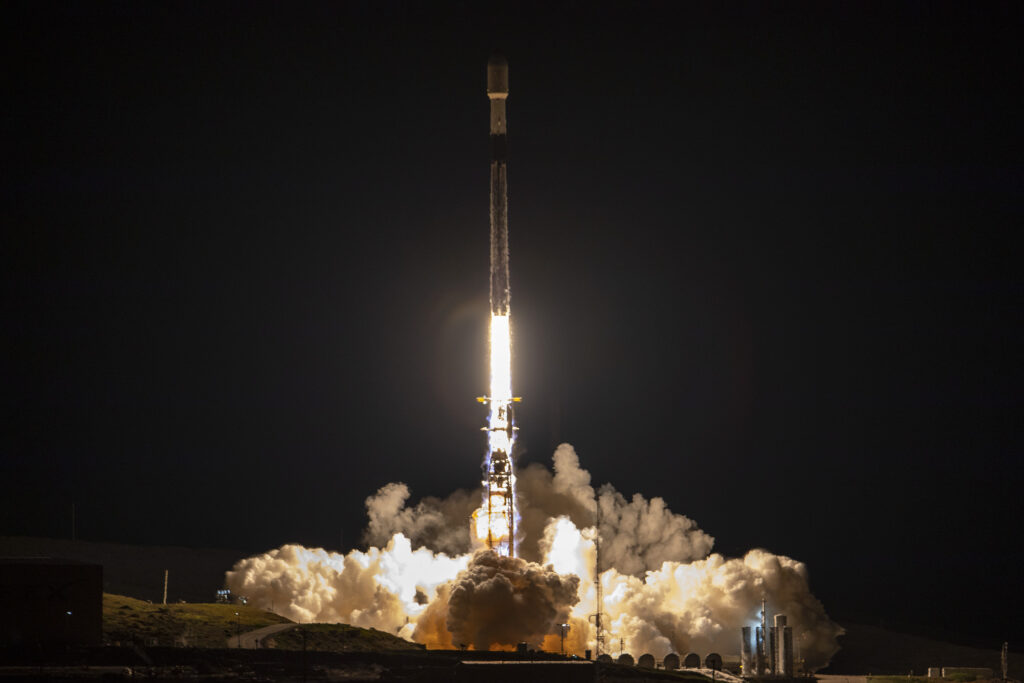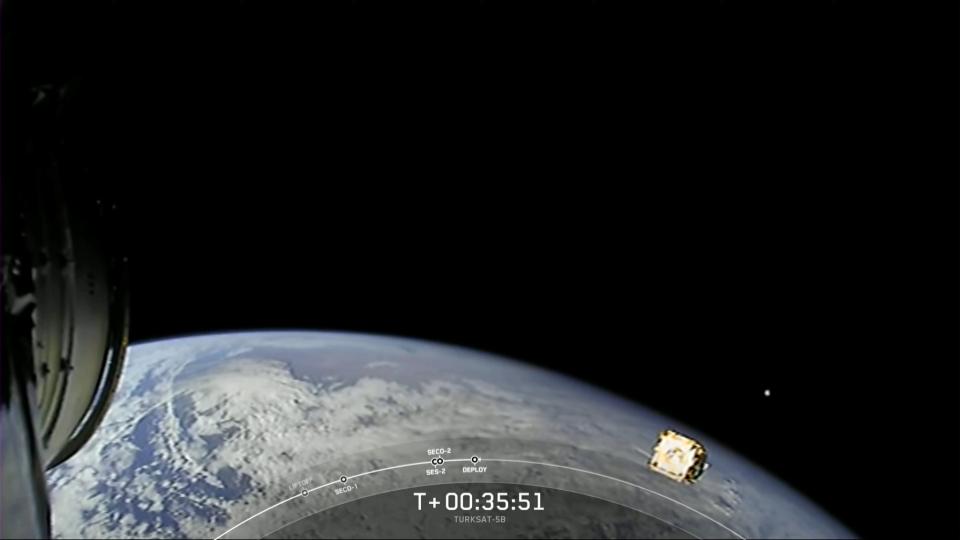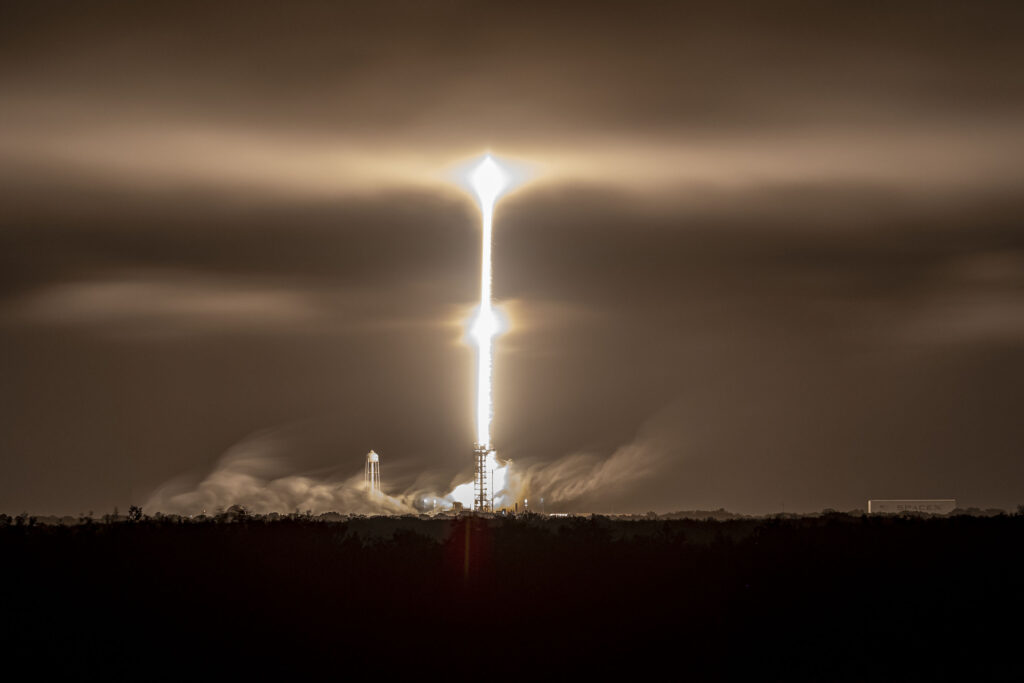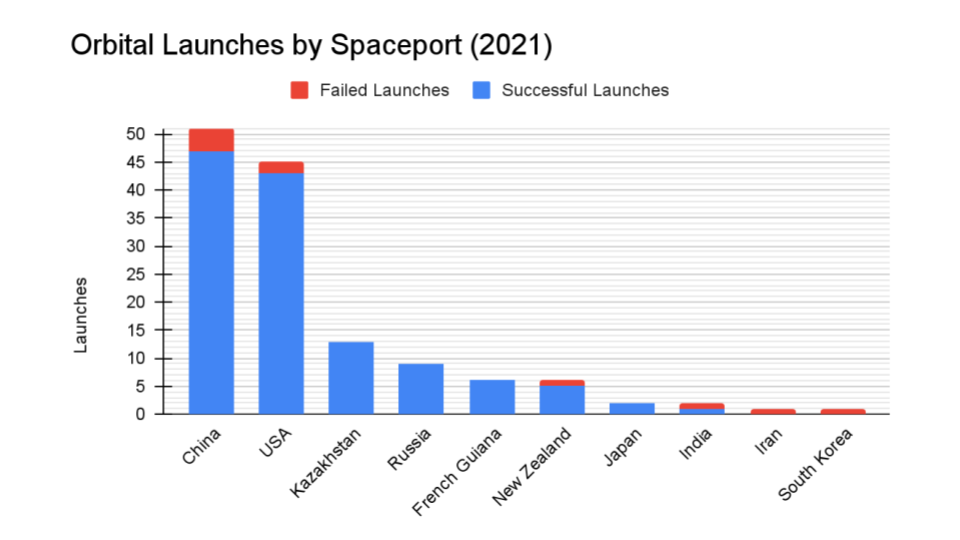This week on Rocket Roundup, we have all the Falcon 9 launches! And another Kuaizhou 1A launch failure to wrap up the year. Plus, we look back at the origins of NORAD’s Santa Tracker.
Podcast
Show Notes
More Starlinks… that is all
- Starlink 28 discussion (Reddit)
- Launch video
SpaceX launches Turkish satellite
- Türksat 5B mission (SpaceX via Archive Today)
- Turkey’s Turksat 5B satellite launched into space (Anadolu Agency)
- Launch video
More supplies to the ISS
- Experiments Riding 24th SpaceX Cargo Mission to Space Station Study Bioprinting, Crystallization, Laundry (NASA)
- P&G Telescience Investigation of Detergent Experiments (NASA)
- Bioprint FirstAid Handheld Bioprinter (NASA)
- Material Science on Solidification of Concrete (NASA)
- “Cement and concrete as an engineering material: An historic appraisal and case study analysis,” Colin R.Gagg, 28 February 2014, Engineering Failure Analysis
- ELaNa 38 CubeSats: Small Satellites Making a Big Impact (NASA)
- Launch video
This Week in Rocket History: NORAD tracks Santa
- Yes, Virginia, There Is a NORAD (The Atlantic)
- INTERVIEW: Terri Van Keuren, Rick Shoup and Pamela Farrell (NPR via Story Corps)
Transcript
Hello, and welcome to the Daily Space. We’ve got a full house today! I am your host Dr. Pamela Gay.
I am your host Erik Madaus.
I’m Annie Wilson.
And I’m Gordon Dewis.
Most weekdays, the CosmoQuest team is here putting science in your brain. Today, however, is for Rocket Roundup.
Our first launch this week is a Kuaizhou 1A launched from Jiquan on December 15 at 02:00 UTC with two commercial satellites. Unfortunately, the rocket failed during the third stage burn for unknown reasons. Even though no launch photos or videos were released by Chinese media, we still felt that it was worth a mention.

Next, on December 18 at 04:41 UTC, the Starlink 33 mission launched atop Falcon 9 booster 1051 from SLC-4E at Vandenberg Space Force Base in California. This was the record eleventh flight for Booster 1051, which successfully landed on the drone ship Of Course I Still Love You. Both fairings on this launch were reused, with one on its third flight and the other on its fourth.
This launch targeted the 53.2 inclination shell of the Starlink constellation. Because it launched from Vanderberg to that inclination, it only carried 52 satellites to orbit instead of the usual 53. Normally, it would have launched from LC-39A or SLC-40 in Florida, but they were both tied up with two more end-of-year missions for SpaceX: CRS-24 and Türksat 5B.
The trajectory for this launch was unusual because it flew over land directly after liftoff instead of going over the ocean and then turning. Rockets launched in the U.S. typically don’t fly over land. Vandenberg is limited to 56-degree inclination orbits at minimum, so 53 degrees required hugging the coast as much as possible, going over a bit of land south of Lompoc, and bending the trajectory even more eastward during the second stage burn. The second stage conducted a deorbit burn on its second orbit, burning up harmlessly over the South Pacific Ocean.

Next up, on December 19 at 03:58 UTC, a SpaceX Falcon 9 launched the Türksat 5B satellite into geostationary transfer orbit from SLC-40 at Cape Canaveral Space Force Station in Florida.
Twenty minutes after the booster landed, the second stage restarted and sent Türksat 5B into its eccentric geostationary transfer orbit (GTO). Over the next few months, the satellite will circularize at GEO altitude and zero its inclination using its onboard electric engines.
After separation, the SpaceX webcast stayed on the air for a few minutes to show views of the Earth from the second stage camera which was quite special. We don’t usually see views of Earth at this altitude.
Türksat 5B is the second in a series of dual-use civilian and military satellites for the Republic of Turkey. Twenty-five percent of the satellite is built in Turkey, specifically the three X-band transponders intended for government use. The satellite weighs 4.5 metric tons at launch, half the weight of a T-Rex.
Electric propulsion allows smaller satellites to launch on Falcon 9 to a regular GTO and still permits SpaceX to recover the first stage. The tradeoff is that the satellite spends much more time getting on station – months instead of weeks – because the engines produce much less thrust. It also spends more time passing through the Earth’s radiation belts, which increases the risk of damage to its electronics and degrades its solar panels.
Türksat 5B is expected to last up to 35 years.
From one payload which will be active for a third of a century to one which will only be in space for a month or so.

On December 21 at 10:07 UTC, a SpaceX Falcon 9 launched the CRS-24 resupply mission towards the International Space Station (ISS) from LC-39A at the Kennedy Space Center in Florida. The final SpaceX launch of 2021 used capsule C209, which marked its second flight.
Like most of the CRS missions SpaceX flew in 2021, the first stage for this mission was a brand new booster, Booster 1069. The last maiden flight of a booster was B1067, which first flew on CRS 22 six months ago, in June 2021.
Booster 1069 landed about nine minutes after launch on the droneship Just Read the Instructions, making this the one-hundredth successful landing of a Falcon 9 booster six years to the day of the first one.
As usual, CRS-24 brings with it lots of science and station equipment. There are too many to talk about in the time that we have, so here are a few of our favorites.
One experiment being brought up by CRS-24 is laundry detergent. I know – laundry is boring. It’s a hard, thankless task that never ends. But at least here on Earth, we can do our laundry. Currently, astronauts on the ISS do not wash their clothes. They can’t – the process would use a lot of precious water that the existing filtration system simply can’t get clean enough for humans to drink. Instead, crew members wear the same item of clothing several times and then throw it out with the rest of the space station’s trash by burning it up in the atmosphere. For future missions beyond Earth orbit, astronauts may not be capable of getting fresh new clothes on a regular basis, so they will need the ability to do laundry.
Proctor & Gamble’s cleverly named PGTIDE experiment has two objectives: to determine the efficacy of the active ingredient, amine oxide, on stain removal in microgravity and to see if any part of the detergent’s enzymes or surfactants become inactive or break down and become less effective with extended time in microgravity.
To test how effective amine oxide is in space, the astronauts will first stain and then clean cotton swatches using Tide Pens and Tide To Go Wipes. They will also clean swatches that were stained on the ground.
The second part of the experiment is much simpler. Detergent samples will be brought up to the station and stored for six months. The astronauts will take pictures of the samples at various points to track changes, like cloudiness or color. Both parts of the experiment will be returned to the ground at the same time.
The BioPrint FirstAid experiment will demonstrate the use of “bio-ink” bandages made from an astronaut’s own skin cells, which ensures that the body won’t reject it while accelerating the healing process. It also has the benefit of avoiding potential allergic reactions to materials in a conventional bandage, such as latex or adhesive.
BioPrint FirstAid will allow an astronaut to treat themselves quickly without relying on ground-based medical support. The completely mechanical device can make a personalized patch in only ten minutes. Since the purpose of this initial demonstration is to see how the “[t]he distribution pattern of the printed samples on Earth compare[s] to the printed sampled in space”, the first demonstration of the technology won’t contain human cells or be used directly on an astronaut’s body. Instead, the astronaut will strap foil to their arm or leg and then use the bioprinter to apply a simulated patch to the foil.
My favorite experiment is the ESA-sponsored “concrete hardening” experiment. It will investigate how cement mixed with different aggregates, from sand to simulated lunar regolith, affects how the resulting concrete hardens in microgravity.
Concrete is the most common building material and the second most used substance in the world after water. The right concrete for a particular application is a balance between its three major ingredients: aggregates, cement, and water. Aggregate in this context is simply material such as crushed rock, sand, or even old concrete that provides the structure for cement to bind together, creating a matrix for everything to bond to.
The optimal ratio depends on cost and the required amount of strength. If there’s not enough water, not all of the aggregate will bind to the cement, reducing its strength. Too much water and the concrete’s strength is reduced because of pores in the material that let water permeate it. Too much cement and it has lower strength and is more expensive because cement requires a lot of energy to produce. Too much aggregate and the concrete is hard to pour and brittle when cured. Of course, it’s a lot more complicated than that: there are different kinds of aggregate for different uses, but this is a show about rockets, not civil engineering.
Determining how concrete hardens in space will be essential to building large permanent structures on other solar system bodies. Using readily available local materials instead of bringing materials with the mission will allow much more science to get done.
Once the concrete is cured in space, it will be brought back to Earth for analysis, focusing on its pore microstructure and mechanical strength.
CRS-24 also contains the CubeSats of NASA’s ELaNa 38, a few CubeSats from JAXA, and two payloads which will be mounted to the outside of the Kibo module.
To read more about the experiments on CRS-24, you can check out the link in the show notes and Patreon supporters can check out the bonus content for this show, too.
In total, CRS-24 brought up 2,989 kilograms of cargo including packing material: 2,081 in the capsule and 908 in the trunk.
This Week in Rocket History

Instead of a mission or spacecraft event like normal to wrap up the year, we felt it was appropriate to talk about the uniquely North American tradition of NORAD “tracking Santa Claus”. The story starts on Christmas Eve 1948 when the U.S. military alerted the public to the activities of one “unidentified sleigh”.
Seven years later, in 1955, a Sears advertisement in Colorado invited children to call Santa “day and night”, and he’d personally respond. But the phone number that was printed didn’t ring a phone at the North Pole. Thanks to a typo in the ad, callers were instead connected to the phone on Colonel Harry Shoup’s desk at the Continental Air Defense Command. According to an interview with Colonel Shoup’s children, a child dialed the misprinted number and asked if he was talking to Santa. The colonel thought it was a joke at first, which made the child cry. Realizing what had happened, he quickly played along with the child. The calls kept coming, so a few airmen were assigned to answer the phone to act like Santa Claus.
When Colonel Shoup went into work on Christmas Eve, he was greeted by a drawing of Santa’s sleigh on a map, which was probably created by a bored airman that was also on duty that night. Instead of ordering the airmen to take it down, Shoup called a local radio station to report an unidentified flying object that looked like a sleigh. That quickly led to radio stations calling him asking for updates on Santa’s location.
Colonel Shoup apparently had no intention of making this an annual tradition but decided to keep it up after the Associated Press called asking for Santa updates. When NORAD was founded as a combined agency of the United States and Canada in 1958, the organization continued the tradition.
Over the years, the methods of announcing the progress of Santa’s annual journey changed. In 1999, the NORAD Santa Tracker website was set up, providing a live map showing Santa’s whereabouts. In 2008, Santa’s progress started being announced on Twitter via @NoradSanta.
And it’s not just computer technology that is used. All of NORAD’s military assets are used to track and escort Santa as he travels over North America, including fighter jet escorts by both Canadian and American military jets as he makes his trip. Fortunately for the jets, Santa slows down so they can escort him!
Even the space-borne sensors located in a geo-synchronous orbit are used. These satellites have infrared sensors, meaning they can see heat. When a rocket or missile is launched, a tremendous amount of heat is produced – enough for the satellites to see them. It turns out that Rudolph’s nose gives off an infrared signature similar to a missile launch, so the satellites can detect Rudolph’s bright red nose with no problems.
In 2020 and again in 2021, the years when the COVID-19 pandemic has caused so many things to be canceled, the NORAD Santa Tracker continues to operate unaffected. If you want to see where Santa is on Christmas Eve, you can visit www.noradsanta.org with your parents.
Statistics
To wrap things up, here’s a running tally of a few spaceflight statistics for the current year:
Toilets currently in space: 8: 4 installed on ISS, 1 on the Crew Dragon, 1 on the Soyuz, 1 on the Shenzhou, and 1 on Tianhe
Total 2021 orbital launch attempts: 136, including 10 failures
Total satellites from launches: 1,713
We keep track of orbital launches by where they launched from, also known as spaceport. Here’s that breakdown:

China: 51
USA: 45
Kazakhstan: 13
Russia: 9
French Guinea: 6
New Zealand: 6
Japan: 2
India: 2
Iran: 1
South Korea: 1
Your random space fact is that a geologist’s hammer was left on the Moon. Apollo 17 astronaut Jack Schmitt, the only professional geologist to set foot on the Moon, threw his rock hammer away from the lunar lander during an EVA.
This has been the Daily Space.
You can find more information on all our stories, including images, at DailySpace.org. As always, we’re here thanks to the donations of people like you. If you like our content, please consider joining our Patreon at Patreon.com/CosmoQuestX.
HAPPY NEW YEAR!
Credits
Hosts: Pamela Gay, Annie Wilson, Erik Madaus, and Gordon Dewis
Writers: Gordon Dewis, Pamela Gay, Erik Madaus, and Annie Wilson
Audio and Video Editing: Ally Pelphrey
Content Editing: Beth Johnson
Executive Producer: Pamela Gay
Intro and Outro music by Kevin MacLeod, https://incompetech.com/music/


 We record most shows live, on Twitch. Follow us today to get alerts when we go live.
We record most shows live, on Twitch. Follow us today to get alerts when we go live.